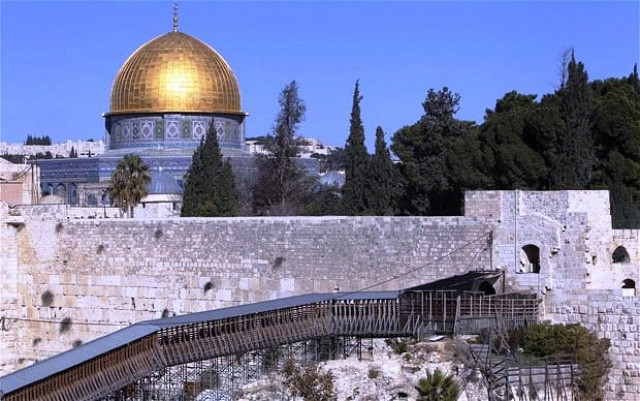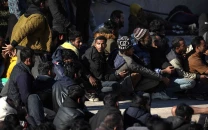A Palestinian plan to attract Muslims back to al Aqsa
Muslims have informally boycotted the holy site since Israel seized East Jerusalem, West Bank from Jordan in 1967 war.

The difference is political, not religious. The first two mosques are in Saudi Arabia, a proudly Muslim kingdom, while al Aqsa stands on Israeli-controlled land that may be the most disputed religious spot on earth.
Jews call the raised ground at the eastern edge of Jerusalem's Old City the Temple Mount, while Muslims know it as the Noble Sanctuary. Both claim sovereignty over it.
Muslims have kept up an informal boycott of the walled esplanade since Israel seized East Jerusalem and the West Bank from Jordan in a 1967 war, saying visits would amount to recognition of Jewish occupation of Palestinian territory.
Palestinian and Jordanian officials now want to reverse that.
President Mahmoud Abbas urged Muslims last February to resume the journeys to Jerusalem to counter what he called Israel's attempts to "Judaise" the city and in solidarity with the Palestinians.
"Visiting a prisoner is an act of support and does not mean normalisation with the warden," he said.
Since then, several high-ranking Arab and Islamic leaders have turned up to pray at al Aqsa and - they hope - kickstart a new wave of pilgrimages.
"Some Muslims haven't visited al Aqsa mosque since 1967, but this was a big mistake," said Palestinian Religious Affairs Minister Mahmoud al Habash.
"We have now decided to correct our mistake."
Temple, mosque and dome
A senior Muslim official involved in the plan said one to two million foreign pilgrims could visit al Aqsa annually if access were free and unimpeded.
"It would protect al Aqsa and also provide an enormous boost to the Palestinian economy," he said. He asked not to be named because of the sensitivity of the issue.
Jerusalem was traditionally a stop for Muslims on overland routes to or from the annual haj pilgrimage in Saudi Arabia.
What they found was a tranquil esplanade with two jewels of Islamic architecture, an elegant mosque highlighted by arabesque stained glass windows and the octagonal Dome of the Rock clad in ornate tiles and topped by a gilded cupola.
The Dome was built by Jerusalem's Arab conquerors in 691 on the spot where Muslims say the Prophet Mohammad began his Night Journey to heaven.
This is also where Judaism's two Bible-era Temples once stood, the first destroyed by the Babylonians in 586 BC and the second levelled by the Romans in 70 AD. The Western Wall, the last remnant of the second structure, is one of the most sacred sites in Judaism.
The crowded plaza in front of the Western Wall and the calm park-like enclosure around the mosque and the Dome seem worlds apart. The one link from the Jewish Quarter of Jerusalem's Old City is a shaky wooden ramp leading to the Mughrabi Gate, right next to the Western Wall. This is the main entry for non-Muslim visitors.
Muslims enter the compound from the Muslim Quarter through 10 other gates through the ancient walls, past checkpoints manned by Israeli security forces. Palestinian authorities escort their guests through the Gate of the Tribes, at the opposite end of the compound from the ramp.
So few foreign Muslims have visited the 35-acre compound in recent decades that many Arabs were surprised to hear the news in mid-April that Egypt's Grand Mufti Ali Gomaa, the second-highest religious authority in the Arab world's most populous country, had gone to pray there.
Gomaa and Jordanian King Abdullah's chief religious adviser, Prince Ghazi bin Muhammad, added an interfaith dimension to their tour by visiting the Church of the Holy Sepulchre – said to be on the site of Jesus's crucifixion and burial - at the invitation of the Greek Orthodox Patriarchate of Jerusalem.
Two weeks before that, Habib Ali al Jifri, an influential Sufi preacher from Yemen, had toured it with Abdullah's brother Prince Hashem. Their visit was less noticed, but after Gomaa turned up, a pattern seemed to emerge.
Several Jordanian politicians and a Bahraini delegation have also made the pilgrimage to al Aqsa and Muslim officials said more high-level visits were expected, both from the Arab world and by Muslims from Europe and Asia.
Controversy
In his appeal last February, Abbas condemned the expanding Jewish settlement of East Jerusalem, which Palestinians see as the capital of a hoped-for future state, and accused Israel of excavating near the disputed site with the aim of undermining al Aqsa itself.
Mohammad Ahmad Husein, the Grand Mufti of Jerusalem and Palestine, issued a fatwa approving the pilgrimages.
But a split appeared almost immediately.
Sheikh Yusuf al Qaradawi, a Qatari-based spiritual leader of the Muslim Brotherhood and one of the world's leading Muslim preachers, issued his own fatwa against foreign Muslims visiting Jerusalem.
Hamas, Abbas's Brotherhood-linked Palestinian rivals in Gaza, denounced the plan as "a gift to the (Israeli) occupation by legitimising its presence". The Egyptian parliament, dominated by conservatists after a post-Arab Spring election, called on Gomaa to resign.
The mufti answered his critics via Twitter: "Visiting Jerusalem increases one's feelings of rejection of occupation and injustice and helps strengthen the (Palestinian) cause."
In Israel, Prime Minister Benjamin Netanyahu denounced Abbas's remarks as "a complete fabrication" that "could start a religious war."
In the Old City's Muslim Quarter abutting the disputed mount, Palestinians seemed unsure what to make of the campaign.
"Jerusalem has undergone countless occupations throughout history, and it was never a problem to come visit it, so I don't understand why it's suddenly a problem," said Sharif Qaddoumi, 26, a researcher at al Quds University.
"Personally, I think people need to come and support Jerusalem," said Hussam Salaymeh, a 41-year-old taxi driver. "But I understand the argument that considers it normalisation with Israel. Politically, I do think it is normalising the situation."
Speaking in his Ramallah office, Habash framed the al Aqsa issue in the wider context of Israel's tightening grip on East Jerusalem, which it annexed in 1967, and parts of the occupied territories.
"In al Aqsa, we don't want to see a repetition of what happened in Hebron," he said, referring to the West Bank town and its Tomb of the Patriarchs, which was controlled by Muslims for centuries and known to them as Ibrahimi (Abraham's) Mosque.
"After the 1967 war, Israel began letting settlers pray in the Ibrahimi Mosque. Step by step, day by day, year by year, they occupied more than half the mosque and made that into a synagogue," he said.
Vips and other muslims
In the absence of any movement towards a peace settlement, practically speaking it is hard to see how many foreign Muslims can follow the path that Gomaa, Jifry and their Jordanian escorts have indicated.
Israel's official position is that all pilgrims are welcome to visit the mosques, churches and synagogues under its control, a policy that contrasts with Jordan's ban on Jewish visitors when it controlled East Jerusalem from 1948 to 1967.
"Any member of any religion is welcome," said Foreign Ministry spokesman Yigal



















COMMENTS
Comments are moderated and generally will be posted if they are on-topic and not abusive.
For more information, please see our Comments FAQ